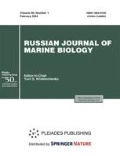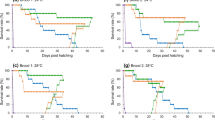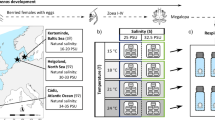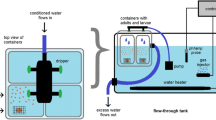Abstract
The possibility of using the adaptive capacity of the larvae of marine invertebrates under the variation of environmental parameters was studied as a sensitive test of sea water pollution. The object of the research was the larvae of Cryptonatica janthostoma (Naticidae), the environmental factor was the freshening of sea water, and the toxic factor used was copper ions. Adding copper to sea water at a concentration of 0.005 mg/l did not reveal any pronounced effect on the development, behavior and growth of larvae in conditions of normal salinity (32‰), however their adaptive potential decreased with a decrease of salinity to 24‰. The results of the present work and experiments carried out previously enabled us to conclude that before assessing any concentration of pollutant as one not affecting marine organisms, it is necessary to investigate not only their development, growth and survival, but also their adaptive capacity relative to the variation of natural environmental parameters, such as even temperature and salinity.
Similar content being viewed by others
References
Andronikov, V.B., Thermosustainability of Germinal Cells and Embryos of Poikilotherm Animals, Teploustoichivost’ kletok zhivotnykh (Thermosustainability of Animal Cells), Moscow, Leningrad: Nauka, 1965.
Berger, V.Ya., Adaptatsii morskih mollyuskov k izmeneniyam solenosti sredy (Adaptations of Marine Mollusks to Variation of Environmental Salinity), Leningrad: Nauka, 1986.
Berger, V.Ya., Pakhomov, A.N., and Mukhlenov, A.G., Study of Isozyme Composition of Esterases and Lactate Dehydrogenase at Adaptation of Mollusc Littorina littorea to Variation of Environmental Salinity, Zhurn. obsch. biol., 1975, vol. 36, no. 4, pp. 579–584.
Brykov V.A. and Selin, N.I., Impact of Sea Water Freshening on Population of Japanese Sallop, Biol. morya, 1990, no. 4, pp. 70–73.
Vashenko, M.A., Autoradiographic Research of Impact of Water-soluble Hydrocarbons of Light Diesel Fuel on RNA and Protein Synthesis in Oocytes of the Sea Urchin Strongylocentrotus nudus, Biol. morya, 1983, no. 4, pp. 47–51.
Vashchenko, M.A., Zhadan, P.M., and Yevtushenko, Z.S., Variation of Protein Synthesis and Enzyme Activity in Gonads and Progeny of Sea Urchins Reared in Environment with Hydrocarbons, Biol. morya, 1990, no. 4, pp. 40–43.
Evtushenko, Z.S., Belcheva, N.N., and Lukyanova, O.N., Biochemical Changes in Body of the Sea Urchin Strongylocentrotus intermedius under Various Concentrations of Cadmium in Water, Biol. morya, 1988, no. 3, pp. 38–44.
Lukanin, V.V. and Khlebovich, V.V., Effect of Inhibitors of Protein Synthesis on Metamorphosises and Adaptive Ability of Scyphomedusa Aurelia aurita (L) Subjected to Desalination, Ontogenez, 1979, vol. 10, no. 1, pp. 80–83.
Naumov, Yu.A. and Naidenko, T.H., Ecological Condition of Nakhodka Bay, Izv. TINRO, 1977, vol. 122, pp. 524–537.
Kharazova, A.D. and Berger, V.Ya., Variation of RNA Synthesis in Tissues of the Mollusc Littorina littorea under Decrease of Environmental Salinity, Tsitologiya, 1974, vol. 16, no. 2, pp. 241–243.
Khristoforova, N.K., Bioindikatsiya i monitoring zagryazneniya morskikh vod tyazhelymi metallami (Bioindication and Monitoring of Heavy Metal Pollution of Sea Water), Leningrad: Nauka, 1989.
Yakovlev, Yu.M., and Kolotukhina, N.K., Reproduction of the Gastropods Cryptonatica janthostoma (Deshayes, 1841) and Lunatia pila (Pilsbry, 1911) (Gastropoda, Naticidae) in Sea of Japan, Byul. Dal’nevost. malakol. o-va, 1995, no. 1, pp. 62–69.
Yaroslavtseva, L.M. and Karpenko, L.A., Study of the Role of Organism and Cell Mechanisms of Some Coastal Mollusks in Adaptation to Desalination, Biol. morya, 1980, no. 3, pp. 80–87.
Yaroslavtseva, L.M. and Sergeeva, E.P., Effect of Desalination on Various Stages of Development of Sea Urchins of the Strongylocentrotus genus, Biol. morya, 1991, no. 6, pp. 47–52.
Yaroslavtseva, L.M. and Sergeeva, E.P., Adaptive Potential of Larvae of the Sea Urchin Strongylocentrotus nudus under Long- and Short-term Desalination, Biol. morya, 1992, no. 1–2, pp. 59–69.
Yaroslavtseva L.M. and Sergeeva, E.P., Effect of Temperature on Early Stages of Development of the Sea Urchin Strongylocentrotus intermedius, Biol. morya, 1994, vol. 20, no. 3, pp. 229–237.
Yaroslavtseva, L.M. and Sergeeva, E.P., Application of Salinity Adaptations of Larvae of the Gastropod Lottia versicolor to Testing of Environmental Pollution, Biol. morya, 1996, vol. 22, no. 5, pp. 306–310.
Yaroslavtseva, L.M. and Sergeeva, E.P., Salinity Adaptation of Larvae of the Sea Urchin Strongylocentrotus intermedius in Phenol Polluted Environment, Biol. morya, 1997, vol. 23, no. 3, pp. 186–189.
Yaroslavtseva, L.M. and Sergeyeva, E.P., Salinity Adaptation of the Gastropods Littorina mandshurica and L. squalida from Saline and Desalinated Habitats, Biol. morya, 2001, vol. 27, no. 4, pp. 286–291.
Yaroslavtseva, L.M. and Sergeyeva, E.P., The Vertical Distribution of Pelagic Larvae of Some Species Marine Gastropods under Freshening and Increase of Temperature on Surface of Water Column, Byul. Dal’nevost. malakol. o-va. 2006, no. 10, pp. 88–101.
Yaroslavtseva, L.M. and Sergeyeva, E.P., Effect of Temperature on Early Development of the Pacific Mussel Mytilus trossulus (Bivalvia: Mytilidae) in Sea Water Polluted by Copper Ions, Biol. morya, 2007, vol. 33, no. 6, pp. 417–422.
Yaroslavtseva, L.M. and Sergeyeva, E.P., Effect of Copper Ions on Behavior of Larvae of the Sea Urchin Strongylocentrotus intermedius in Various Temperatures of Sea Water Biol. morya, 2008 (in press).
Bayne B. Growth and the Delay of Metamorphosis of the Larvae of Mytilus edulis (L.), Ophelia, 1965, vol. 2, no. 1, pp. 1–47.
Dinnel, P.A., Link, J.M., Stober Q.J., et al., Comparative Sensitivity of Sea Urchin Sperm Cell Bioassay to Metals and Pesticides, Arch. Environ. Contam. Toxicol., 1989, vol. 18, pp. 748–755.
Durkina, V.B. and Evtushenko, Z.S., Changes in Activity of Certain Enzymes in Sea Urchin Embryos and Larvae after Exposure of Adult Organisms to Heavy Metals, Mar. Ecol. Prog. Ser., 1991, vol. 72, no. 2, pp. 111–115.
Cherian, M. and Nordberg, M., Cellular Adaptation in Metal Toxicology and Metallothionein, Toxicology, 1983, vol. 28, no. 1–2, pp. 1–15.
Harms, J., Effects of Temperature and Salinity on Larvae Development of Elminius modestus (Crustacea, Cirripedia) from Helgoländ (North Sea) and New Zealand, Helgoländ. Wiss. Meeresuntersuch., 1986, vol. 40, pp. 355–376.
Lehnberg, W. and Theede, H., Combinierte Wirkungen von Temperatur, Salzgehalt und Cadmium auf Entwicklung, Wachstum und Mortalität der Larven von Mytilus edulis aus der westlichen Ostsee, Helgoländ. Wiss. Meeresuntersuch., 1979, Bd 32, S. 179–199.
Neuhoff, H.-G., Synergistic Physiological Effects of Low Copper and Various Oxygen Concentrations of Macoma balthica, Mar. Biol., 1983, vol. 77, no. 1, pp. 39–48.
Rosenberg, R. and Costlow, J.D., Synergistic Effects of Cadmium and Salinity Combined with Constant and Cycling Temperatures on the Larval Development of Two Estuarine Crab Species, Mar. Biol., 1976, vol. 38, no. 3, pp. 291–303.
Runnstrom, S., Weitere Studien über die Temperaturanpassung der Fortpflanzung und Entwicklung mariner Tiere, Bergens Mus. Arbok, 1929, vol. 10, pp. 1–46.
Theede, H., Scholz, N., and Fischer, H., Temperature and Salinity Effects on the Acute Toxicity of Cadmium to Laomedia loveni (Hydrozoa), Mar. Ecol. Progr. Ser., 1979, vol. 1, no. 1, pp. 13–19.
Tkalin, A.V., Belan, T.A., and Shapovalov, E.N., The State of Marine Environment near Vladivostok, Russia, Mar. Pollut. Bull., 1993, vol. 24, no. 8, pp. 418–422.
Westernhagen, H., Dethlefsen, V., and Rosenthal, H., Combined Effects of Cadmium and Salinity on Development and Survival of Garpike Eggs, Helgoländ. Wiss. Meeresuntersuch., 1975, Bd 27, S. 268–282.
Westernhagen H., Rosenthal H., and Sperling K.R. Combined Effects of Cadmium and Salinity on Development and Survival of Herring eggs, Helgoländ. Wiss. Meeresuntersuch., 1974, Bd 26, S. 416–433.
Author information
Authors and Affiliations
Corresponding author
Additional information
Original Russian Text © L.M. Yaroslavtseva, E.P. Sergeeva, 2009, published in Biologiya Morya.
Rights and permissions
About this article
Cite this article
Yaroslavtseva, L.M., Sergeeva, E.P. Adaptation capacity of the larvae of marine invertebrates under variation of environmental parameters as a sensitive test of sea water pollution. Russ J Mar Biol 35, 127–131 (2009). https://doi.org/10.1134/S1063074009020035
Accepted:
Published:
Issue Date:
DOI: https://doi.org/10.1134/S1063074009020035




